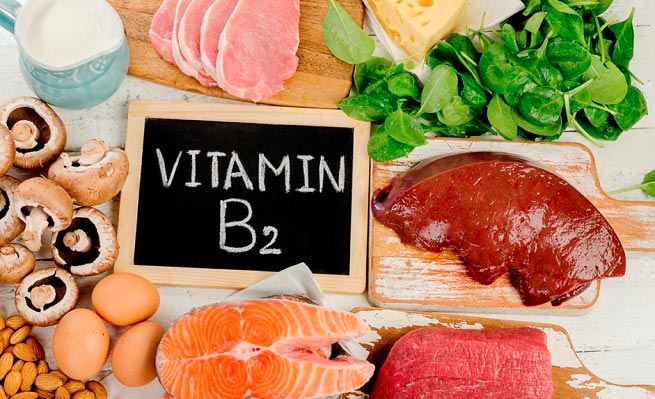Riboflavin (Vitamin B2)
Riboflavin is the only water-soluble vitamin used as a food coloring. In fact, it is named for its color — the Latin word flavus means “yellow.”
Types
In addition to riboflavin, dietary substances known as flavoproteins release riboflavin during digestion.
Two of the most common flavoproteins are flavin adenine dinucleotide and flavin mononucleotide. They are found in a wide range of foods.
Role and Function
- Riboflavin functions as a coenzyme in various chemical reactions.
- Like thiamine, it is involved in the conversion of nutrients into energy. It is also required in the conversion of vitamin B6 to its active form, and in the conversion of tryptophan to niacin (vitamin B3).
Dietary Sources
- The chart below shows the riboflavin content of some of its richest dietary sources.
- Yeast extract spread is also exceptionally rich in riboflavin, containing around 18 mg in every 100 grams. Other good sources of riboflavin include eggs, leafy vegetables, broccoli, milk, legumes, mushrooms and meat.
- Additionally, riboflavin is often added to processed breakfast cereals and is used as a yellow-orange food coloring.
Recommended Intake
The table below shows the RDA or adequate intake for riboflavin. These values represent the daily intake sufficient to meet the requirements of most people.
RDA (mg/day)
Infants 0–6 months 0.3*
7–12 months 0.4*
Children 1–3 years 0.5
4–8 years 0.6
9–13 years 0.9
Women 14–18 years 1.0
19+ years 1.1
Men 14+ years 1.3
Pregnancy 1.4
Lactation 1.6
*Adequate intake
Deficiency
- Riboflavin deficiency is very rare in developed countries. However, a poor diet, old age, lung diseases and alcoholism may increase the risk.
- Severe deficiency results in a condition known as ariboflavinosis, which is characterized by a sore throat, inflamed tongue, anemia, as well as skin and eye problems.
- It also impairs the metabolism of vitamin B6 and the conversion of tryptophan to niacin.
Side Effects and Toxicity
- High intake of dietary or supplemental riboflavin has no known effects of toxicity.
- Absorption becomes less efficient at higher doses. Also, very small amounts are stored in body tissues and excess riboflavin is flushed out of the body with urine.
- As a result, the safe upper intake level of riboflavin has not been established.
Benefits of Supplements
- In most cases, riboflavin supplements do not have any benefits for people who already get enough from food.
- Yet, low-dose riboflavin supplements may potentially reduce blood pressure and lower the risk of heart disease in people who are genetically predisposed to them. It’s thought to do this by decreasing high homocysteine levels in those with two copies of the gene MTHFR 677TT.
- Higher doses of riboflavin, such as 200 mg twice a day, may also reduce migraines.
Summary of Riboflavin
- Riboflavin, also known vitamin B2, is a coenzyme with various essential functions. For instance, it is required for converting nutrients to energy.
- Found in various foods, its richest sources include liver, meat, dairy products, eggs, leafy vegetables, almonds and legumes.
- Deficiency is virtually unknown among healthy people in Western countries, although diseases and poor lifestyle habits may increase the risk.
- High-dose riboflavin supplements are not known to have any adverse effects, but they usually only benefit those who are deficient. However, evidence suggests they may reduce migraines or lower the risk of heart disease in genetically susceptible people.

